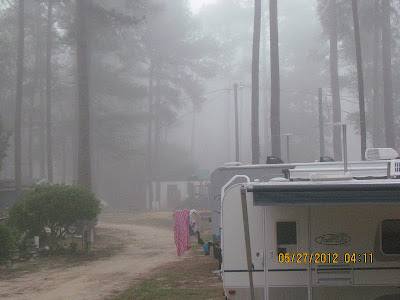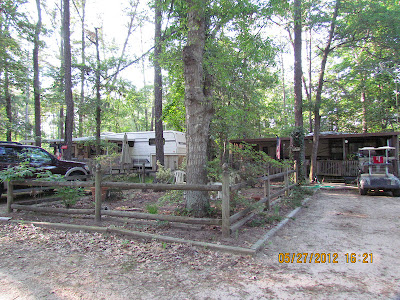Even the plantings and flowers out in front evoke the Civil War era --
There was a small museum inside with some artifacts. This drum was the property of a 13 year-old Union Army drummer boy--
After having checked with their website, we planned our visit to arrive in time to see the hour-long film that is only shown at noon every day. Narrated by James Earl Jones, it uses letter, journal and diary entries to tell the story of the battle in the troops own words. This scene showed Confederate troops wading across the Potomac River as part of General Lee's attempt to move the war out of Virginia and into the north.
It's hard to look out over this bucolic farmland and realize that in a period of little more than twelve hours 23,000 men will be killed, wounded or missing. At the time of the battle in September of 1862, these fields were planted in corn. We bought a set of CDs at the gift shop that we listened to as we drove from place to place to learn about the different parts of that long bloody day.
This line-up of artillery illustrates part of the manufacturing edge that the north had. The first one on the left is a 10-pounder Parrott Rifle and the second is a 3-inch Ordnance Rifle. These rifled artillery pieces were more accurate and could fire farther than the two 12-pounder Napoleon bronze cannons on the right. The Napoleon cannons were left from the Spanish-American War and were the only artillery the Confederacy possessed. Because of the hilly terrain on the battlefield, artillery played an important role in the battle. There were more than 500 artillery pieces used that day!
As a nurse, I was very interested in this stone monument erected in tribute to Clara Barton, known as the "Angel of the Battlefield."
The red cross at the foot of the stone is made from bricks of the chimney or the home where Ms Barton grew up in Massachusetts --
Not only did Ms Barton bring assistance to wounded soldiers, she also brought bandages, lanterns and food to the Antietam hospitals.
There must be a least a hundred different statues and monuments scattered around the various parts of the battlefield. It seems that each state that had troops who fought here, has erected some kind of tribute. There are some states that have multiple monuments, one for each of the units that fought here.
For instance, this monument is at the edge of the infamous bloody cornfield pays tribute to the 1st Texas Volunteer Regiment who lost eight color-bearers who were trying to protect their flag.
This one is for the Fourteenth Brooklyn Infantry unit from New York --
This sunken farm lane, bordered by rail fences was the scene of a bloody ambush of Union troops. 2200 patient Confederate soldiers (later reinforced by additional troops) used it as a breastwork to hold off the attacks of a combined Union force numbering nearly 10,000.
Mathew Brady had cadre of photographers that ventured to the Civil War battlefields to document "the great spectacle of war." They took photographs of the dead "lying in rows along the road like ties of a railroad, in heaps like cordwood mingled with the splintered and shattered fence rails." For the first time in history, the horror of war was brought home to the public. I think the sight of all those horrible pictures -- which are displayed at the museum and throughout the battlefield -- made me feel quite heartsick about all the carnage.
This monument to the Irish Brigade was especially poignant to me. In the gift shop I saw recruiting posters for the Irish to volunteer to serve in the Union Army side-by-side with the signs that were in the store windows saying "No Irish Need Apply!" Sounds like our present day immigrants volunteering in hopes of earning their US citizenship...
Forry and I were both taken by how rocky the fields are. This is a field of corn planted around the rocks...
How would you like to try to plant around rocks like these?
Or these, just scattered throughout the grain?
The Ranger at Harpers Ferry had told me about the Field Hospital Museum that has been set up not too far from the Antietam Battlefield. The Pry farm was one of the places that wounded were taken from the field (there were so many wounded, that almost every house and barn became a hospital).
Not only was the house and barn used for wounded soldiers, the Union Army camped on Pry land for several weeks following the battle, eating all of the farmer's crops and animals. Though Pry tried to reclaim his losses from the US government, his family eventually lost their farm.
There are displays of Civil War era medicine throughout the house. The parlor is set up as it may have been for a field surgery. The table is set upon empty ammo boxes so that the doctor could work upon the soldier's wounded foot. Most likely only officers were treated in the house.
The common soldier was taken to this large barn and treated there.
On our way back to the RV campground, tired and hungry, we once again crossed over the Potomac River. I could picture those Rebel soldiers wading back across after the Union Army had foiled their attempt to invade Maryland.
Though the battle pretty much ended up in a stalemate, President Lincoln was encouraged enough about thwarting General Robert E Lee, that he felt it was time to issue the Emancipation Proclamation.






















































